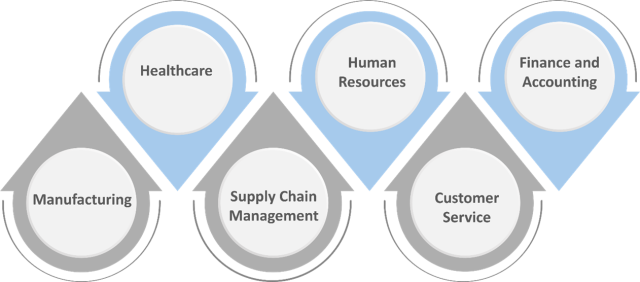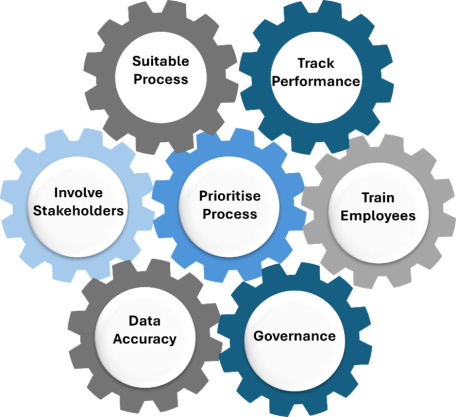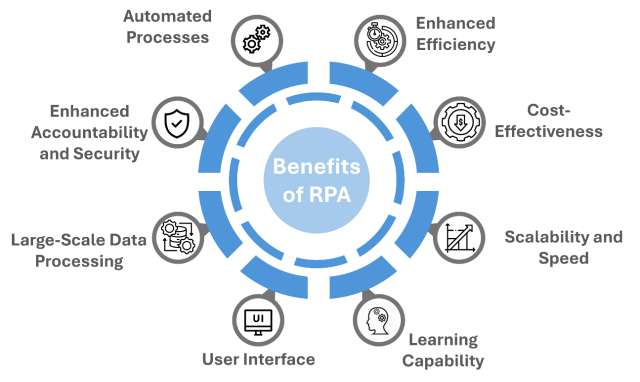For an organization to remain competitive in today’s digital landscape optimizing efficiency and cost-effectiveness should be the primary goals. These goals can be achieved once an organization undergoes digital transformation. Digital Transformation involves keeping in sync with technology, creating seamless efficient processes, enhancing and upgrading the skills of people and thus bringing in an overall change in the culture of the organization.
Robotic Process Automation (RPA) is a pivotal force in digital transformation, helping organizations streamline operations by automating repetitive, rule-based tasks. The RPA market is growing rapidly, with a projected value of $13.74 billion by 2028, reflecting a compound annual growth rate (CAGR) of 32.8%, according to Grand View Research. This surge highlights the increasing reliance on RPA to boost efficiency, reduce errors, and allow human resources to focus on strategic initiatives.
RPA plays a critical role in enhancing productivity, accelerating processes, and ensuring consistency across various functions, from data entry to customer service. As digital adoption accelerates, RPA offers a scalable, cost-effective solution to optimize workflows, improve compliance, and adapt to the evolving technological landscape, solidifying its role in modern business transformation.
Continue reading the blog to explore more about RPA, and its role in digital transformation journey.
What is Robotic Process Automation (RPA)?
RPA is a key component of digital transformation, helping organizations automate repetitive tasks, improve efficiency, and reduce errors.
Although the term “RPA” was engaged with a lot in the 2000s, its roots go back to the 1990s. Although there were still drawbacks with automation, yet it was the banking and insurance companies that implemented automation. Managing huge amounts of data and configuration of systems was humanely impossible.
A vital component of automation, screen scraping, which ensured seamless automation of data extractions from applications, proved to be the turning point that led to businesses adopting automation. It was in the 2020s that RPA reached its pinnacle of fame and was integrated into the workflows and processes of companies from large corporations to small businesses leading to massive productivity.
Due to its ability to streamline processes and reduce costs, RPA is necessary in most business intending to stay in the competitive digital market.
Role RPA plays in Digital Transformation & Its Benefits
Customer experience is crucial to the survival of most businesses.
The use of automation tools empowers an organization to manage its end-to-end-business processes, respond to changing market conditions, increase organizational efficiency, and reduce human intervention and errors.
RPA introduces automation and speeds up the process that would take any human hours to perform. In a way it kind of mimics human actions to perform rules-based tasks with complete accuracy, but faster. Nonetheless, RPA bots, or automation ‘software bots’ on their own don’t learn from their actions or adjust to changes. The bots, automated to function in certain ways simply carry out routine repetitive administrative tasks.
How does RPA Work?
- Repetitive Tasks Automated: Routine, rule-based tasks like data entry, invoice processing, customer support & service performed by humans are automated.
- Bot Usage: Software robots or “bots” mimicking repetitive human actions such as logging into applications, moving files, and extracting data, are used by RPA to perform these tasks.
- Flexibility with Legacy Systems: RPA bots can interact with legacy systems without requiring changes to the underlying infrastructure. This makes RPA a flexible and non-intrusive solution for digital transformation.
Benefits of RPA in Digital Transformation
By automating repetitive and time-consuming tasks, RPA enhances operational efficiency, reduces errors, and lowers costs. It enables organizations to streamline workflows, allowing employees to focus on higher-value activities that drive innovation and growth. Additionally, RPA ensures consistency and compliance across processes, making it a vital tool for businesses looking to scale their operations while maintaining quality.
- Seamless Process & Improved Efficiency: RPA performs repetitive tasks and reduces time, providing for focus on strategic activities
- Cost Reduction: Automation of routine tasks reduces manual labor, human errors, and thereby operational costs
- Higher Accuracy: Elimination of human errors provides for consistency in business processes
- Improved Accountability & Security: Bots never err! Reduces risk of human errors
- Scalability & Speed: Provision of automation bots handle increased workloads allowing for Speed & scalability of operations
- Learning Capability: RPA can enhance its performance by leveraging insights from past experiences. By integrating Machine Learning (ML) algorithms, bots can analyze performance data, identify areas for improvement, and continuously optimize processes over time.
- User Interface: Bots supporting customer-facing inquiries leads to faster resolutions & response times
- Large-scale Data Processing: RPA excels at handling large volumes of data from multiple sources, significantly improving processing speed while minimizing the risk of errors
RPA has gone beyond simple task automation to complex and advanced learning and decision-making using the new Generative Artificial Intelligence (GAI) and its subsets like Machine Learning (ML).
This intersecting and symbiosis of AI and RPA has led to the emergence of Cognitive Automation or Intelligent Automation (IA). Intelligent automation empowers organizations to make data-driven decisions quickly, accurately, and efficiently, bringing a major paradigm shift in the workflow process. Let’s see how this has evolved.
The Paradigm Shift: From “Doing” the Tasks to “Thinking” Through the Tasks
Thus far, RPA bots have been trained to do repetitive jobs quickly. However, the introduction of Machine Learning (ML) has led to the involvement of a learning process. ML mimics human learning behavior making decisions and adapting when required. ML algorithms analyze and learn from data, and then make predictions for future behaviors – without requiring human interference.
When leveraging and integrating tools of AI like ML with RPA in enterprise systems, a transformation approach to working with processes and workflows occurs – not just a technological shift but shifting towards a problem-solving and decision-making model.
RPA works with structured data performing repetitive tasks. Integrating ML into the RPA process leads to working with structured and unstructured data transforming rule-based automation to decision-making automation process without human intervention!
| RPA | RPA+ML |
| Simple Repetitive tasks | Complex automated tasks |
| Works with Structured Data only | Gathers insights from unstructured or semi-structured data from multiple sources |
| Focus on “Doing the tasks”/ Rule-based automation | Focus on “Thinking through the tasks”/Smart Analytics & predictions |
| Quick tactical wins | Long-term strategic decisions |
| Optimizes specific tasks on a need-be basis | Optimizes various processes in real-time |
| Hardly any investment & cost effective | Larger Investment due to training and infrastructure but later higher productivity & ROIs |
Given the dynamic nature of ML, RPA can be trained to clean the data every time new data is fed into the ML algorithm, and thus achieve a fully effective and efficient solution to automation in its truest sense of no human intervention.
For these two to work together for a successful digital transformation adequate design, planning and governance of an overall automation approach is essential. This approach requires the integration of a host of certain capabilities such as: Data capture, ingestion, and cleaning, data enrichment, automation output, quality control, end-of-the-line analytics, and exception case handling, including an emphasis on back-end features like system integration, auto-scaling, capacity management, security & compliance.
How ML Integrates with RPA for a Successful Digital Business Process Transformation
- Intelligent Automation: RPA handles rule-based tasks, and ML enables bots to handle tasks that require decision-making and adaptability. Using ML models to analyze data, recognize patterns, and make predictions, RPA bots can support the execution of more complex and dynamic processes.
- Natural Language Processing (NLP): When ML-powered NLP is integrated, it allows RPA bots to understand and process human language, thus enabling automation of tasks like sentiment analysis, document processing, and chatbots for customer service.
- Computer Vision: Utilization of ML algorithms in computer vision enables RPA bots to interpret and interact with visual data, such as reading and processing invoices or recognizing images in different contexts.
- Self-Learning Bots: When RPA bots are integrated with Ml capability, they can continuously improve by learning from new data and feedback. This adaptive learning capability allows bots to handle exceptions and become more accurate over time.
ML broadens RPA’s capabilities by enabling the processing of unstructured data such as emails, PDFs, images, and videos. Integrating ML models empowers RPA bots to make data-driven decisions, facilitating the automation of more complex business processes. Additionally, ML-driven predictive analytics allow RPA bots to anticipate and address potential issues proactively, reducing the risk of system failures. Furthermore, ML algorithms enable RPA bots to continually improve by learning from historical data and outcomes, leading to more efficient and effective automation over time.
Also read our blog on ML in CX Engineering
Use Cases of RPA and ML in Digital Transformation
RPA combined with ML offers transformative potential across various industry verticals and powerful use cases in digital transformation. Exploring these applications finds how RPA and ML together steer efficiency and innovation across diverse industries.

| Use Cases | RPA | RPA+ML |
| Finance And Accounting | RPA can automate invoice processing, expense reporting, and compliance checks | ML can enhance these processes by detecting anomalies, predicting cash flow, and assessing risk |
| Customer Service | RPA automates routine inquiries | ML enhances this by analyzing customer sentiment, providing personalized responses, and predicting customer nee |
| Human Resources | RPA handles tasks like employee onboarding, payroll, and benefits administration | ML assists in talent acquisition by analyzing resumes, predicting employee turnover, and optimizing workforce planning |
| Supply Chain Management | RPA automates order processing and inventory management | ML predicts demand, optimizes inventory levels, and identifies supply chain risks |
| Healthcare | RPA automates patient scheduling, billing, and claims processing | ML aids in diagnosing diseases, predicting patient outcomes, and personalizing treatment plans |
| Manufacturing | RPA can optimize plant floor performance with track & trace, increase speed of repetitive tasks and reduce human errors | ML can improve device management and increase visibility, and predict preventive maintenance by identifying and isolating issues and inefficiencies with greater precision. |
Nonetheless, like every device and process, challenges exist that need to be considered before going for a complete digital transformation overhaul.
Integrating RPA with machine learning (ML) and existing IT systems presents several challenges, including complex planning and execution. While RPA can be smoothly integrated with legacy systems, combining it with ML requires careful consideration. Data quality is another significant challenge; ML models depend on high-quality, accurate, and up-to-date data to be effective. Poor data quality can undermine predictions and the automation process itself. Additionally, when RPA is used for web scraping, it must be carefully monitored. Security and compliance are also crucial, as automating processes involving sensitive data demands robust security measures to prevent breaches and ensure adherence to regulations.
Best Practices for RPA Digital Transformation
Successful RPA digital transformation demands meticulous planning and execution. Consider the following steps as you embark on this journey:

- Identify Suitable Processes: Select repetitive, rule-based tasks that require minimal decision-making. This makes it easier for bots to manage these tasks effectively and enhances the likelihood of successful automation.
- Prioritize Automation Processes: Rank processes based on their organizational impact and automation complexity. Begin with high-impact, low-complexity tasks and progressively tackle more complex processes as you gain experience.
- Engage key Stakeholders: Engage stakeholders from various departments in the RPA implementation process to ensure that automation aligns with overall business objectives and addresses key needs.
- Guarantee Data Accuracy: Verify that data is accurate and consistent across systems. Since bots depend on data to execute tasks, any inaccuracies or inconsistencies can result in errors and operational failures.
- Monitor Performance: Regularly track bot performance to identify and address issues. Utilize metrics such as cycle time, error rates, and productivity to optimize and refine processes.
- Train Employees: Provide training for employees on interacting with bots and managing exceptions. This will facilitate a smooth transition to automated processes and foster greater acceptance among staff.
- Establish Governance Framework: Implement governance frameworks for RPA digital transformation to ensure regulatory compliance and adherence to standards, thereby mitigating potential risks and issues.
Conclusion
RPA plays a pivotal role in digital transformation by automating repetitive tasks, improving efficiency, and reducing costs. When combined with ML, RPA becomes a more powerful tool, capable of handling complex, dynamic processes that require decision-making, pattern recognition, and continuous improvement. At Calsoft, we recognize that in today’s competitive digital landscape environment organizations need not just be efficient but also cost-effective. With RPA and ML tools, Calsoft can support and enable organizations to achieve greater levels of automation, drive innovation, and stay competitive in an increasingly digital world.



